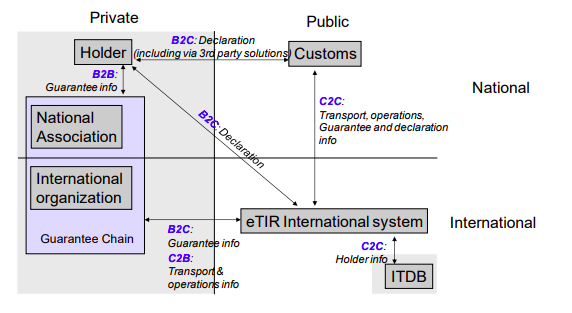A. General Information
eTIR
B. Lessons Learned
The eTIR provides an exchange platform for all actors involved in the TIR system. It ensures the secure exchange of data between national customs systems related to the international transit of goods, vehicles or containers and it allows customs to manage data on guarantee.
To ensure the secure exchange of data between national customs systems related to the international transit of goods, vehicles or containers according to the provisions of the TIR Convention and to allow customs to manage the data on guarantees, issued by guarantee chains to holders authorized to use the TIR system.
The United Nations Economic Commission for Europe (UNECE) administers the TIR Convention, which was established in 1959 and extensively revised in 1975 and which has, at present, 76 Contracting Parties. The TIR Convention provides for an internationally recognized procedure to facilitate the cross border transportation of goods in transit through the use of a standard, internationally recognized customs document, the TIR Carnet, which also serves as proof of existence of an internationally valid guarantee.
For many years the TIR Convention proved to be an efficient facilitation tool. However, with the progress in technology, the use of the paper TIR Carnet is increasingly becoming archaic, in particular when it comes to linking it to the electronic procedures applied by national customs administrations. At each border crossing, customs officers are generally forced to process the paper TIR Carnet on top of the electronic processing in national electronic customs systems. In addition, the current situation does not enable customs authorities to effectively apply risk management procedures based on advance cargo information, as demanded by an increasingly more security-conscious environment.
The Contracting Parties to the TIR Convention launched in 2003 the so-called “eTIR Project”, aimed at providing an exchange platform for all actors (Customs authorities, holders, guarantee chains) involved in the TIR system, known as the “eTIR international system”. The eTIR international system aims to ensure the secure exchange of data between national customs systems related to the international transit of goods, vehicles or containers according to the provisions of the TIR Convention and to allow customs to manage the data on guarantees, issued by guarantee chains to holders authorized to use the TIR system.
Development of and international electronic transit system
 This figure represents the information exchange between the actors in the eTIR system. The eTIR system depends on parallel efforts from contracting parties, transport operators and the guarantee chains to develop/ update and interconnect governmental and private sector ICT systems.
This figure represents the information exchange between the actors in the eTIR system. The eTIR system depends on parallel efforts from contracting parties, transport operators and the guarantee chains to develop/ update and interconnect governmental and private sector ICT systems.
Transit declaration and guarantee information
In the early stages of the project, the guarantee chain, possibly fearing changes in their business model, severely slowed down the project.
Contracting parties to the TIR convention have only started in 2015 to work on a new Annex to the Convention, which aims at providing the required legal basis for eTIR. Reaching consensus on the news annex has proved challenging and, while almost all contracting parties are ready to adopt the draft annex, discussions are still ongoing to reach a consensus on its finalization and adoption.
Starting the work on the legal basis in parallel to the preparation of the functional specification could have allowed for an earlier adoption of the legal text and might have helped to speed up the whole project.
Increased collaboration with the private sector in the early stages of the project could have prevented years of negotiations.
The eTIR system offers benefits to all actors involved in the TIR system. First, it brings additional security and risk management opportunities, thus reducing the risk of fraud. Second, advanced international cooperation will allow all actors to significantly reduce their administrative burden and to maximize the benefits of integrated supply chain management. Finally, the provision of advance cargo information and the exchange of information in real time will speed up the TIR procedure.
In 2015, further to the signature of an MoU between UNECE and the IRU in the field of the computerization of the TIR procedure, the IRU provided UNECE with the funds required to start an eTIR pilot project between Iran (Islamic republic of) and Turkey. In 2017, UNECE and IRU signed 5 years MoU and Contributions Agreement aimed at financing the UNECE activities related to projects contributing to the full computerization of the TIR procedure.
Iran and Turkey are preparing a MoU aimed at progressively expand the scope of their eTIR pilot project to all transport operators and all customs.
Iran and Azerbaijan are starting an eTIR project aimed at improving trade and transport along the International North-South Transport Corridor (INSTC).
Azerbaijan, Georgia, Kazakhstan and Ukraine are starting an intermodal eTIR project.
Finally, the efforts undertaken by all contracting parties to the convention to introduce a new Annex in the convention will provide the legal basis for all contracting parties to operationalize eTIR globally. Taking into consideration that the TIR Convention has seen in recent years a renewed global interest (since 2015 Oman, Argentina, Qatar, the State of Palestine, India, China and Pakistan acceded to the Convection) the potential geographical scope of eTIR is increasing.

